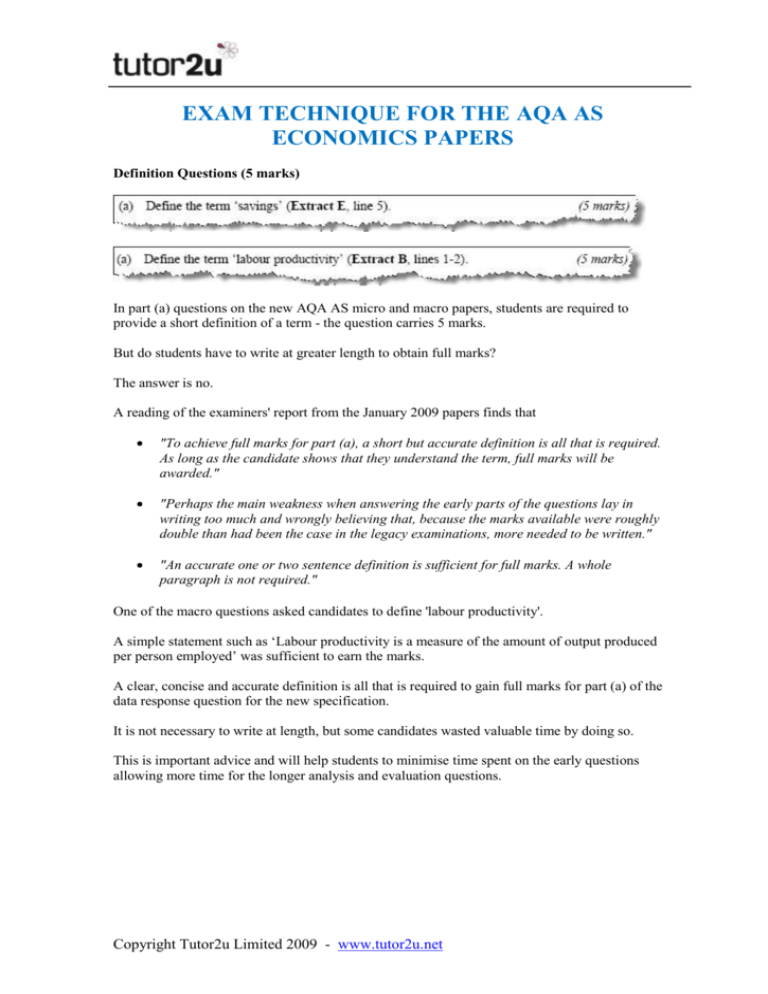exam technique for the as papers on 3rd june
advertisement

EXAM TECHNIQUE FOR THE AQA AS ECONOMICS PAPERS Definition Questions (5 marks) In part (a) questions on the new AQA AS micro and macro papers, students are required to provide a short definition of a term - the question carries 5 marks. But do students have to write at greater length to obtain full marks? The answer is no. A reading of the examiners' report from the January 2009 papers finds that "To achieve full marks for part (a), a short but accurate definition is all that is required. As long as the candidate shows that they understand the term, full marks will be awarded." "Perhaps the main weakness when answering the early parts of the questions lay in writing too much and wrongly believing that, because the marks available were roughly double than had been the case in the legacy examinations, more needed to be written." "An accurate one or two sentence definition is sufficient for full marks. A whole paragraph is not required." One of the macro questions asked candidates to define 'labour productivity'. A simple statement such as ‘Labour productivity is a measure of the amount of output produced per person employed’ was sufficient to earn the marks. A clear, concise and accurate definition is all that is required to gain full marks for part (a) of the data response question for the new specification. It is not necessary to write at length, but some candidates wasted valuable time by doing so. This is important advice and will help students to minimise time spent on the early questions allowing more time for the longer analysis and evaluation questions. Copyright Tutor2u Limited 2009 - www.tutor2u.net Data description questions (8 marks) The second question on the AQA units 1 and 2 papers asks students to identify features of selected economic data - usually in the form of a chart and/or table. The question carries 8 marks. I produced a quick revision exercise on this aspect of the new paper a few weeks ago. The January 2009 Examiners’ reports make for important reading once again “For part (b), the candidate only needed to identify two distinct features of the data and use figures to support their description. Many candidates understood this but some of the answers were far too long.” “Some candidates did not appear to realise that figures must be quoted. Also, despite the instruction to ‘identify two main features’, there were a few candidates who just provided a chronological description of the chart in words.” “Numerous candidates adopted the familiar trawl approach instead of taking an overview and providing broad points of comparison, backed up by some illustrative statistical data. Maybe the fact that 8 marks are now available for this question led many candidates to the view that a lot of writing was necessary. This is not the case.” Copyright Tutor2u Limited 2009 - www.tutor2u.net Explanation questions (12 marks) Part (c) explanation questions in the new AQA AS papers score 12 marks. For example in the January 2009 macro paper students were faced with this question: “Extract B suggests that international studies ‘provide explanations for differences in labour productivity’. Explain two determinants of labour productivity.” On the other question “Explain two determinants of saving by households” The examiners’ report gives some important clues as to how to approach these questions and achieve high marks with the minimum of fuss. (i) Avoid a scatter-gun approach - pick two determinants and explain / develop them do not leave it to the examiner to determine the best two explanations within your answer (ii) Use two separate paragraphs. In the first paragraph, the first determinant should be stated in the first sentence and the rest of the paragraph should be used to develop the explanation. This process should then be repeated for the second determinant. (iii) Go back to the data in the stimulus materials to help your answer. The most commonly quoted determinants of labour productivity were: training (or skills), incentives, job insecurity, investment in capital goods and improvements in technology. (iv) Succinct definitions still count - some marks are available for relevant definitions but not for repeating the definition that was required in part (a). If there are technical terms in your answer e.g. savings ratio, disposable income, human capital - then offer a brief and accurate definition - this will help achieve maximum marks for part (c) Copyright Tutor2u Limited 2009 - www.tutor2u.net (v) In micro questions a diagram is nearly always called for explicitly in the question and should form the centre piece of the answer - but once drawn, avoid laborious descriptions of it. Focus instead on explaining relationships. Analysis and evaluation questions (25 marks) The 25 mark questions make or break your grade and uniform mark on this paper. You have a choice and care should be taken before committing yourself to an answer - read through all of the questions first. That said - the direction of the question looks similar with each. Take the Jan 2009 paper as an example Using the data and your own economic knowledge, evaluate the significance of household savings for UK macroeconomic performance (25 marks) Using the data and your own economic knowledge, evaluate the significance of higher labour productivity in bringing about improvements in UK macroeconomic performance (25 marks) The 25 mark questions can often be quite daunting - but here are some simple but important tips: 1) Analysis diagrams: In my view, making effective use of AD-AS diagrams is absolutely crucial to scoring well on these questions. There should always be at least one AD-AS diagram and sometimes more, especially when you are making a distinction between short run and long run changes and their effect on macro performance. “Diagrams were sometimes used to support explanations and it is strongly recommended that teachers encourage their students to use them whenever it is appropriate.” 2) Macroeconomic performance: This phrase comes up all of the time. It is open to interpretation but in your revision, always try to consider what a change in this or that economic variable might mean for The control of inflation / avoidance of deflation Maintaining high employment / job opportunities / low unemployment rates Achieving sustainable economic growth in the short and long run Improving a country’s international competitiveness and trade performance Contributing to increased social welfare / rising standards of living /quality of life Improving the state of public (government) finances - i.e. a sustainable fiscal position. 3) Consider both demand and supply-side effects: This is important! Take the two variables chosen for the Jan 2009 paper, namely household savings and productivity. A rising savings ratio or an improvement in productivity can have significant effects both on the level of aggregate demand and the short run business cycle and also influence long run aggregate supply - which has implications for trend growth and trade. 4) Make good use of the stimulus material: Note the question says “using the data” ....the extracts and charts are there for a reason - make good use of them e.g. going back to the data to support an answer - but avoid slavishly repeating the material ... this is data response, not data ignore or data drown! 5) Using your own knowledge: Often the difference between a good answer and a superb one. The best students will demonstrate an awareness of what is happening both in the UK and the international economy. Bring that knowledge into play especially when evaluating arguments. The most recent examiners’ report makes this clear: “Candidates are advised to use the media to gain a greater awareness of recent and current economic events.” Copyright Tutor2u Limited 2009 - www.tutor2u.net 6) Make good use of evaluative phrases - such as However In the long run, the most effective policy is likely to be X because …. The arguments are finely balanced but I believe that recent evidence for the UK supports X … A possible disadvantage of this policy is that … This policy is likely to have some effect but it depends on Phrases to avoid! Please do not use these! In summary To conclude As I said before To repeat All in all Copyright Tutor2u Limited 2009 - www.tutor2u.net










